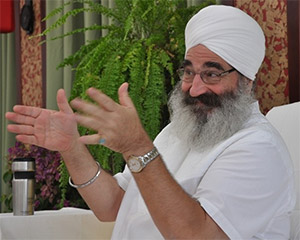Founder president of the Ghadr party in the U.S.A. (1870-1968)
 Was the only son of Bhai Karam Singh, of the village of Bhakna, 16 km southwest of Amritsar. He was born in January 1870 at Khutrai Khurd, parental home of his mother, Ram Kaur, 3 km northeast of Guru ka Bagh in Amritsar district. He learnt reacting and writing Punjabi and the rudiments of Sikh faith in the village gurdwara and passed the fifth primary class in Urdu and Persian at the age of 16. He had been married when He was ten to Bishan Kaur, daughter of Khushal Singh, a landlord of jandiala in Lahore district, but the couple remained childless.
Was the only son of Bhai Karam Singh, of the village of Bhakna, 16 km southwest of Amritsar. He was born in January 1870 at Khutrai Khurd, parental home of his mother, Ram Kaur, 3 km northeast of Guru ka Bagh in Amritsar district. He learnt reacting and writing Punjabi and the rudiments of Sikh faith in the village gurdwara and passed the fifth primary class in Urdu and Persian at the age of 16. He had been married when He was ten to Bishan Kaur, daughter of Khushal Singh, a landlord of jandiala in Lahore district, but the couple remained childless. Sohan Singh took part in the anti-Colonization Bill agitation of 1906-07. Two years later (3 February 1909) he left home to go to the United States, reaching Seattle on the West Coast on 4 April 1909. He soon found work as a labourer in a timber mill, under construction near Seattle. In those days, Indians in the United States and the neighbouring Canada, most. of them Sikhs from the Punjab, suffered severe discrimination, protest against which had been simmering. In the summer of 1913, representatives of Indians living in Canada and the United States, meeting at Stockton, decided to set. up an organization, Hindustani Workers of the Pacific Coast (Hindi Pacific Association, for short). Sohan Singh Bhakna was elected its president and Lala Hardayal, intellectual and revolutionary, its general secretary.
A weekly paper Ghadr (lit. rebellion, revolt) was launched on 1 November 1913 to propagate the objective of the Association, which plainly was to make an armed rebellion against the British in India. The journal Ghadr imparted its name to the organization as well as to the movement itself. The United States government, at the instance of the British, issued arrest warrants against Lala Hardayal, but the party succeeded in smuggling him out. of the country in April 1914. The Ghadr party, under Sohan Singh Bhakna, planned an uprising against the British for 1917, but rumours of a war in Europe between England and Germany and the Komagata Maru episode hastened events. Sohan Singh himself contacted the returning Komagata Maru at Yokohama and delivered to Baba Gurdit Singh a consignment. of arms. As he learnt there that hostilities had actually broken out on 28 July 1914, he took a boat to India. As soon as. the ship reached Calcutta on 13 October 1914, Sohan Singh was arrested and, after a few days interrogation at Ludhiana, was sent to Central Jail, Multan. He was tried in what is known as the first Lahore conspiracy, case and was sentenced to death with forfeiture of property. The death penalty was later commuted to life imprisonment in Andamans, where he reached on 10 December 1915 and where he undertook several hunger strikes successively to secure the detenues better treatment.
In 1921 he was transferred to Coimbatore jail and then to Yervada. Here lie left off eating food again to register his protest against Sikh prisoners not being allowed to wear turbans and their kachhahiras or knickers which were their religious obligations. In 1927, he was shifted
to Central Jail, Lahore, where he again went on hunger strike in june 1928 to protest against the segregation of the so-called low-caste Mazhabi Sikhs from other 'high-caste' Sikhs at mealtimes. He was released early in July 1930, but he continued to work for the freedom of the country. He devoted most of his time to organizing Kisan Sabhas (peasants' societies) . During World War II he was interned in Deoli Camp Jail (Rajasthan) for nearly three years. After Independence he veered decisively towards the Communist Party of India. He was arrested on 31 March 1948, but released on 8 May 1948. However, he was seized again, but jail-going ended for him finally at the intervention of Independent India's first Prime Minister, Jawaharlal Nehru.
Bent with age and ravaged by pneumonia, Baba Sohan Singh Bhakna died, at Amritsar, on 21 December 1968.
to Central Jail, Lahore, where he again went on hunger strike in june 1928 to protest against the segregation of the so-called low-caste Mazhabi Sikhs from other 'high-caste' Sikhs at mealtimes. He was released early in July 1930, but he continued to work for the freedom of the country. He devoted most of his time to organizing Kisan Sabhas (peasants' societies) . During World War II he was interned in Deoli Camp Jail (Rajasthan) for nearly three years. After Independence he veered decisively towards the Communist Party of India. He was arrested on 31 March 1948, but released on 8 May 1948. However, he was seized again, but jail-going ended for him finally at the intervention of Independent India's first Prime Minister, Jawaharlal Nehru.











